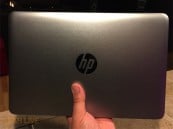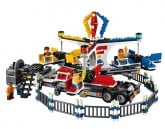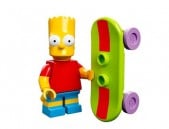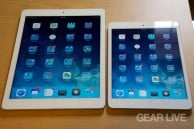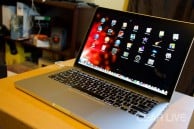Latest Gear Live Videos
PS3 Controller Gains Sensors, Loses Rumble
Posted by Christopher Sasaki Categories: Corporate News, E3, Hardware, PlayStation 3,

Since the last time gamers saw the PS3 controller, there have been some changes. First, of course, is the return of the familiar Dualshock form-factor. The triggers have been tweaked to give them more play, and the sensitivity of the analog pads and buttons has been increased to 10-bit from its original 8-bit resolution. Bluetooth wireless is now standard, and the controller offers a USB port for a wired connection and battery charging. Gone is the rumble feature, and the reason this has been removed is due to a new feature for the controller, a feature that seems awfully similar to one we’ve already seen: the new controller offers on board gyroscopic sensors to direct 3D directional movement. Apparently the rumble feature interferes with the directional sensors, so gamers lose vibrational feedback. While the directional sensors seem a lot like Nintendo’s offering, it isn’t quite the same. Sony’s version of the tilt sensor might seem a bit familiar to gamers that played Motocross Madness on the PC with Microsoft’s Sidewinder Freestyle Pro.
Read More  | Playstation.com
| Playstation.com
Advertisement
PS3: $499 Version Lacks HDMI, Memory Stick
Posted by Christopher Sasaki Categories: Corporate News, E3, Hardware, PlayStation 3,
 According to a press release hosted by Sony, the differences between the two price points extends beyond the size of the hard disk drive. In addition to losing that 40 GB of disk space, the base console loses the HDMI port, support for Memory Stick, CompactFlash, SD media, and loses the built in wireless networking. The loss of memory stick and wireless networking support is kind of a bummer, but the big loss for people looking for an inexpensive Blu-Ray player has got to be the HDMI port. At this time, it is unknown whether there will be expansion options for those who choose to purchase the less expensive version, like the optional hard drive for Xbox 360 Core and Premium packs, so it looks like potential PS3 owners will have to make some choices when the system ships on November 17. Of course, if system availability is anything like what faced holiday Xbox 360 purchasers, people may have to take what they can get.
According to a press release hosted by Sony, the differences between the two price points extends beyond the size of the hard disk drive. In addition to losing that 40 GB of disk space, the base console loses the HDMI port, support for Memory Stick, CompactFlash, SD media, and loses the built in wireless networking. The loss of memory stick and wireless networking support is kind of a bummer, but the big loss for people looking for an inexpensive Blu-Ray player has got to be the HDMI port. At this time, it is unknown whether there will be expansion options for those who choose to purchase the less expensive version, like the optional hard drive for Xbox 360 Core and Premium packs, so it looks like potential PS3 owners will have to make some choices when the system ships on November 17. Of course, if system availability is anything like what faced holiday Xbox 360 purchasers, people may have to take what they can get.
Read More  | Playstation Press Center
| Playstation Press Center
 Anandtech has a review - benchmarks included - of a preview Ageia PhysX card from Asus. The PhysX cards should be on the market soon; the cards were scheduled to be released on May 9th, but some retailers have inventory already. The goal of the PhysX card is to act as a physics accelerator, or PPU, much like current GPU accelerate graphical effects. Initial shipments of the card will run around $299, and, at least at this point, Anandtech finds it difficult to recommend the cards. The card is run through a couple of benchmarks; the first, a test demo from Ageia, performed as expected. Scenes with the PPU enabled perform better than those without, and slower CPUs see more of a benefit from the card than faster ones. However, in the only game that currently supports the PPU acceleration, Ghost Recon: Advanced Warfighter, frames per second actually drops when the physics accelerator is enabled. To some extent, this happens because high end games will typically be GPU limited; throwing more action into the frame increases the number of objects that the GPU has to render, so while the CPU works less, the GPU will have to work more. It is definitely early in the PPU development cycle. Newer games, newer GPU, and the deployment of DirectX 10 could possibly change this picture, but increasing CPU power may sideline the technology unless PPU utilization improves. Expect PhysX cards on the market soon from Asus and BFG Technologies.
Anandtech has a review - benchmarks included - of a preview Ageia PhysX card from Asus. The PhysX cards should be on the market soon; the cards were scheduled to be released on May 9th, but some retailers have inventory already. The goal of the PhysX card is to act as a physics accelerator, or PPU, much like current GPU accelerate graphical effects. Initial shipments of the card will run around $299, and, at least at this point, Anandtech finds it difficult to recommend the cards. The card is run through a couple of benchmarks; the first, a test demo from Ageia, performed as expected. Scenes with the PPU enabled perform better than those without, and slower CPUs see more of a benefit from the card than faster ones. However, in the only game that currently supports the PPU acceleration, Ghost Recon: Advanced Warfighter, frames per second actually drops when the physics accelerator is enabled. To some extent, this happens because high end games will typically be GPU limited; throwing more action into the frame increases the number of objects that the GPU has to render, so while the CPU works less, the GPU will have to work more. It is definitely early in the PPU development cycle. Newer games, newer GPU, and the deployment of DirectX 10 could possibly change this picture, but increasing CPU power may sideline the technology unless PPU utilization improves. Expect PhysX cards on the market soon from Asus and BFG Technologies.
Read More  | Anandtech
| Anandtech
ATI Aquires Bitboys Oy
Posted by Christopher Sasaki Categories: Corporate News, Hardware, Portable/Mobile,
![]() ATI announced via press release that they are acquiring the bad boys of the graphics accelerator world, Bitboys Oy, for approximately $44 million US. Bitboys rose to fame on its early GPU announcements full of hype and promise, that would somehow not materialize, including the Pyramid3D chips and the Glaze3D chips that would supposedly toast the competition. Currently, Bitboys licenses GPU technology to mobile phone development companies, and has worked with providers such as Erikkson and NEC, and has received investments from companies like Nokia. While ATI is ostensibly acquiring Bitboys for its mobile technology, they may also be looking for a company that can output roughly four times the hype than ATIs current marketing provides.
ATI announced via press release that they are acquiring the bad boys of the graphics accelerator world, Bitboys Oy, for approximately $44 million US. Bitboys rose to fame on its early GPU announcements full of hype and promise, that would somehow not materialize, including the Pyramid3D chips and the Glaze3D chips that would supposedly toast the competition. Currently, Bitboys licenses GPU technology to mobile phone development companies, and has worked with providers such as Erikkson and NEC, and has received investments from companies like Nokia. While ATI is ostensibly acquiring Bitboys for its mobile technology, they may also be looking for a company that can output roughly four times the hype than ATIs current marketing provides.
Full Press Release after the jump.
Click to continue reading ATI Aquires Bitboys Oy
Electronic Business Online has published an article from Dean Takahashi, author of the book Opening the Xbox, which detailed how the original Xbox came to be. This time, he takes on the critical missteps that Microsoft made in the original Xbox, and how they tried to fix them in the new Xbox 360. The main problem Microsoft had with the original Xbox was the ownership of the hardware; built from largely off-the-shelf components from partners Intel and nVidia, Microsoft owned very little of the intellectual property for the engine that made the Xbox run. This would make reductions in cost very difficult, and in one case, these issues leaked into the public with Microsoft’s argument with nVidia over GPU costs. This also limited what Microsoft could do with the original Xbox, and while Sony was releasing a streamlined PSTwo to the market to revitalize their market share, Microsoft was stuck with the clunky Xbox. This would also bite them in their plans for the Xbox 360; since Microsoft did not own the IP rights to the GPU in the original Xbox, they would be forced to make a deal with nVidia to license their technology so that they could include backwards compatibility as a feature.
Click to continue reading Xbox 360: Learning from Failure
 HardOCP had a chance to talk with ATI about their work with Microsoft on the upcoming DirectX 10, to be included with Windows Vista. DirectX 10 seeks to reduce the overhead from previous versions of DirectX, as well as increase flexibility to support future GPU. Assuming that Windows Vista makes its currently announced ship date, when DirectX 10 is available, it will have been about 4 years since DirectX 9.0 was released. In that time, users have seen many advancements to the pixel and vertex shaders common in all DirectX 9.0 GPU. DirectX 10 will bring access to a new geometry shader, and support for cards featuring a unified GPU architecture. The Xbox 360’s GPU already supports a unified architecture; this allows a more streamlined use of the features integrated into a GPU, and give the GPU the ability to take on more generalized tasks. Since Halo 2 for the PC will require Windows Vista and the improved DirectX 10, gamers may see a superior port of the game.
HardOCP had a chance to talk with ATI about their work with Microsoft on the upcoming DirectX 10, to be included with Windows Vista. DirectX 10 seeks to reduce the overhead from previous versions of DirectX, as well as increase flexibility to support future GPU. Assuming that Windows Vista makes its currently announced ship date, when DirectX 10 is available, it will have been about 4 years since DirectX 9.0 was released. In that time, users have seen many advancements to the pixel and vertex shaders common in all DirectX 9.0 GPU. DirectX 10 will bring access to a new geometry shader, and support for cards featuring a unified GPU architecture. The Xbox 360’s GPU already supports a unified architecture; this allows a more streamlined use of the features integrated into a GPU, and give the GPU the ability to take on more generalized tasks. Since Halo 2 for the PC will require Windows Vista and the improved DirectX 10, gamers may see a superior port of the game.
Read More  | HardOCP
| HardOCP
 Those gamers wondering if they should upgrade their CPU, or their GPU to more effectively play Oblivion, can look to Anandtech for their answer. The short answer, is both, if you can afford it. Anandtech benchmarks a series of CPUs against the current GPU leader in Oblivion performance, the ATI Radeon X1900 XT CrossFire, and then cross-examines their results by running the same CPU at different speeds against four ATI configurations to give an idea of how well the CPU scales in mid-range to high-end performance scenarios. Clearly, there are a couple of takeaways from this test. First, if gamers have a Radeon X1900XT CrossFire rig, their gameplay is likely to be CPU bound. Second, if gamers want to make the most of a top-end GPU, then they will want an AMD CPU. Very few of the Intel chips made a showing, and the AMD dual-core chips were the clear winner. As always, the middle ground is a lot less clear. There are clearly sections of Oblivion that are going to be highly CPU bound, like the towns in game, and to some extent, the dungeons. Gamers with mid-range CPUs probably aren’t going to see the benefit of a high-end graphics card in Oblivion because of this. Since Oblivion will take advantage of dual-core chips, it might make sense to upgrade to a dual-core first, and approach the GPU later.
Those gamers wondering if they should upgrade their CPU, or their GPU to more effectively play Oblivion, can look to Anandtech for their answer. The short answer, is both, if you can afford it. Anandtech benchmarks a series of CPUs against the current GPU leader in Oblivion performance, the ATI Radeon X1900 XT CrossFire, and then cross-examines their results by running the same CPU at different speeds against four ATI configurations to give an idea of how well the CPU scales in mid-range to high-end performance scenarios. Clearly, there are a couple of takeaways from this test. First, if gamers have a Radeon X1900XT CrossFire rig, their gameplay is likely to be CPU bound. Second, if gamers want to make the most of a top-end GPU, then they will want an AMD CPU. Very few of the Intel chips made a showing, and the AMD dual-core chips were the clear winner. As always, the middle ground is a lot less clear. There are clearly sections of Oblivion that are going to be highly CPU bound, like the towns in game, and to some extent, the dungeons. Gamers with mid-range CPUs probably aren’t going to see the benefit of a high-end graphics card in Oblivion because of this. Since Oblivion will take advantage of dual-core chips, it might make sense to upgrade to a dual-core first, and approach the GPU later.
Read More  | Anandtech
| Anandtech
 It is looking like the US is going to be seeing the DS Lite arrive in June. While gamers had hoped that the DS Lite would be launched in tandem with Mario Bros. DS, GoNintendo.com has gotten a scan of a GameCrazy internal newsletter that shows the DS Lite arriving on the US shores in the June time frame. Unfortunately, the exact date and pricing of the console are not listed, but this is pretty strong confirmation that a May date will not be happening.
It is looking like the US is going to be seeing the DS Lite arrive in June. While gamers had hoped that the DS Lite would be launched in tandem with Mario Bros. DS, GoNintendo.com has gotten a scan of a GameCrazy internal newsletter that shows the DS Lite arriving on the US shores in the June time frame. Unfortunately, the exact date and pricing of the console are not listed, but this is pretty strong confirmation that a May date will not be happening.
Read More  | GoNintendo
| GoNintendo
Revolution Nunchaku Controller Motion Sensing
Posted by Christopher Sasaki Categories: Hardware, Rumors, Wii,
 A developer “incredibly close to Nintendo” has apparently confirmed to Advanced Media Network that the additional “nunchaku” controller add-on for the Nintendo Revolution will also have a built-in accelerometer, allowing it the same motion sensing capabilities of the main controller. If true, this could add an additional element of interaction to games, making the user experience more multi-dimensional. According to AMN’s source, this feature has been included since the shipments of the development kits six months ago. Why this hasn’t been mentioned before was speculated on by AMN, but it could just be that this functionality was assumed to be present and just “confirmed” now.
A developer “incredibly close to Nintendo” has apparently confirmed to Advanced Media Network that the additional “nunchaku” controller add-on for the Nintendo Revolution will also have a built-in accelerometer, allowing it the same motion sensing capabilities of the main controller. If true, this could add an additional element of interaction to games, making the user experience more multi-dimensional. According to AMN’s source, this feature has been included since the shipments of the development kits six months ago. Why this hasn’t been mentioned before was speculated on by AMN, but it could just be that this functionality was assumed to be present and just “confirmed” now.
Read More  | Advanced Media Network
| Advanced Media Network
PS3, Xbox 360 GPUs Compared
Posted by Christopher Sasaki Categories: Hardware, PlayStation 3, Xbox 360,
 Impress Watch Japan has just published the latest in a series of articles comparing the PS3 and the Xbox 360. This time, the technical specifications of the GPUs go under the microscope, along with a comparison to the current GPU offerings from nVidia and ATI. Since Google’s translation tools often leave much to be desired when trying to understand the details of an article, a forum member at Beyond 3D has offered their translation. Most interesting are the comments from various anonymous developers; there’s a lot more feedback on the Xbox 360, since it has been on the market longer. One developer says that to work around some of the memory restrictions, developers can render to an internal frame buffer of either 960x540 or 880x540 and then upscale the output for 720p using the built in Display Controller—so gamers may not be getting “true” HD resolutions. In both the PS3 and Xbox 360’s design, though, it looks like memory bandwidth is going to be the killer. Trying to mix high resolution textures with enough of a frame buffer to render HD resolutions is difficult for these machines at 720p, and 1080p for the PS3 is going to be difficult when mixed with multi-sample anti-aliasing; the trade-off will be high resolutions with fewer effects, or lower resolutions with more effects and MSAA implemented. So far, most developers appear to be taking the second approach.
Impress Watch Japan has just published the latest in a series of articles comparing the PS3 and the Xbox 360. This time, the technical specifications of the GPUs go under the microscope, along with a comparison to the current GPU offerings from nVidia and ATI. Since Google’s translation tools often leave much to be desired when trying to understand the details of an article, a forum member at Beyond 3D has offered their translation. Most interesting are the comments from various anonymous developers; there’s a lot more feedback on the Xbox 360, since it has been on the market longer. One developer says that to work around some of the memory restrictions, developers can render to an internal frame buffer of either 960x540 or 880x540 and then upscale the output for 720p using the built in Display Controller—so gamers may not be getting “true” HD resolutions. In both the PS3 and Xbox 360’s design, though, it looks like memory bandwidth is going to be the killer. Trying to mix high resolution textures with enough of a frame buffer to render HD resolutions is difficult for these machines at 720p, and 1080p for the PS3 is going to be difficult when mixed with multi-sample anti-aliasing; the trade-off will be high resolutions with fewer effects, or lower resolutions with more effects and MSAA implemented. So far, most developers appear to be taking the second approach.
Read More  | Original Impress Watch Article
| Original Impress Watch Article
Read More  | Beyond3D Translation
| Beyond3D Translation
Advertisement
© Gear Live Media, LLC. 2007 – User-posted content, unless source is quoted, is licensed under a Creative Commons Public Domain License. Gear Live graphics, logos, designs, page headers, button icons, videos, articles, blogs, forums, scripts and other service names are the trademarks of Gear Live Inc.



